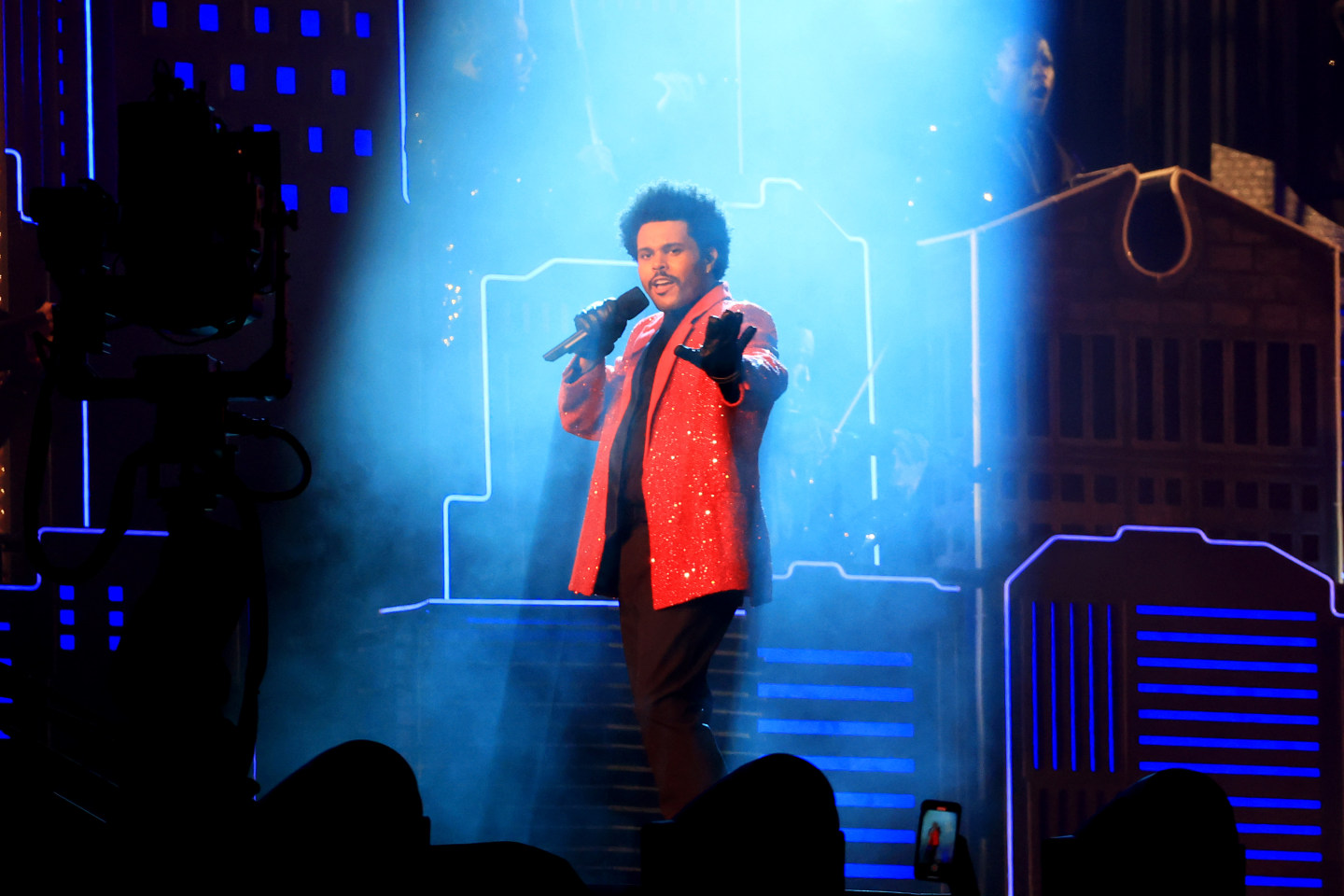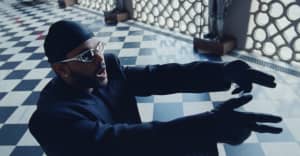 Mike Ehrmann / Getty Images
Mike Ehrmann / Getty Images
The Weeknd’s career can often feel like a grand, winking joke. Think about the bullet points of Abel Tesfaye’s decade-long run to this point: A lurid, distressed debut mixtape that made sex jams out of Cocteau Twins and Beach House samples. A pair of No. 1 singles that leaned on, respectively, a heavy cocaine metaphor and three-second slabs of harsh noise. A record made with Daft Punk, which carved out daytime radio ubiquity despite doubling down on the cocaine-and-light-choking aesthetic of records past with a title track that sounded more like Matthew Dear than Discovery. A cameo playing himself in a film by indie auteurs du jour Josh and Benny Safdie in which he gets in a fistfight with Adam Sandler. An album inspired by the underappreciated corners of the Scorcese catalogue which, in spite of its strange, violent visual style, ended up becoming one of the biggest of the year and, in the process, pretty much destroyed an entire generation’s goodwill towards the Grammys.
One can’t really plan for these things, of course, but throughout his career, The Weeknd has played off these surreal clashes of abject darkness and high celebrity with a wry, knowing smirk. Unlike, say, Drake, who still seems blithely unaware of the gag value of his own fame, The Weeknd looks directly into the camera and laughs: “Isn’t it a little stupid, seeing me perform this song at the American Music Awards?” Aside from the fact that his music is consistently good, paying attention to The Weeknd’s career can feel like watching the genesis of a good meme — more than anything, it’s fun to see how he can continue to project the same imagery in bigger and more surreal ways, year after year.
On Sunday evening, during a sublime and utterly strange Super Bowl halftime performance in Tampa, Florida, The Weeknd dished out the best, most insane version of The-Weeknd-as-meme yet. He eschewed the traditional hallmarks of the modern Super Bowl halftime show — a handful of surprise, often unrelated guests; glamorous costume changes; some kind of aerial stunt — for something internal, surreal, and silly. The whole thing was one big smirk to camera, a send-up of the pop star industrial complex that played up the ridiculousness of The Weeknd playing at the Super Bowl while cementing his status as one of pop’s last remaining legitimate male stars. Although The Weeknd’s sense of humor is generally pretty dark, there were gags baked into this set. Ahead of the show, he stated that $7 million of his own money was going into this show, the kind of provocation that, hilariously, seemed to enrage people afterwards who couldn’t fathom how you could possibly put that amount of money into a show and have the end product come out so pared-back. At the same press conference, he assured journalists the show was going to present a “PG” version of his music, a seeming impossibility unless he were to only perform covers.
Rather than play as a victory lap for last year’s After Hours, the Super Bowl set played more like a greatest hits reel celebrating a decade of pulling dank, narcissistic R&B into the mainstream. Aesthetically and musically, this didn’t actually have much bearing on the tenor of the show. Abel still showed up in his red suit — this time redone by Givenchy with hand-embroidered crystals, giving the impression of, depending on how you want to read it, the glitter of flash bulbs, broken glass, or wet blood — and the set was still based around the lost-in-Vegas theme of the After Hours videos. And although he was drawing from four or five different records, the setlist rarely felt disjointed. This speaks to one of the main criticisms of The Weeknd — that he basically does the same thing every album — which, in my mind, is pretty much the point.
It’s helpful to think of The Weeknd as the designer of a legacy fashion house: He has his codes and his favorite shapes, and each record merely presents an opportunity to remix and refine those codes based on the key themes or ideas of the era. Some collections are more refined and more distinctive than others, while some present interesting and necessary creative stopgaps before more show-stopping seasons, but everything is simply a manifestation of a particular brand or ethos, as opposed to a true reinvention. So The Weeknd at the Super Bowl is a little like Maison Margiela for H&M, or Rodarte for Target, a display of cultural power or significance that’s also an opportunity to redo iconic moments and looks in a way that’s accessible, recognizable, family-friendly.
Of course, you’re never going to get a Tabi boot in a Margiela for H&M collection, and so the Super Bowl was noticeably free of any hardcore, fan-service Weeknd. We got none of the clubbier side of After Hours, none of The Weeknd’s eternal muse Lana Del Rey, no “High For This”-calibre roughness, no “Call Out My Name”-style dark vaudeville. He exchanged that sharper edge for something a little more thoughtful than usual, more symbolic, and more in tune with the fact that what’s not seen can often be more unnerving than what is. The Super Bowl is a historically loaded arena for pop music, which makes it a perfect canvas for The Weeknd, given that so much of the After Hours rollout has considered the simultaneous ridiculousness and darkness of fame, from the body horror of plastic surgery to the dangers of being given an unfettered supply of drugs and alcohol to the soullessness of A-list life.
The meta-commentary of The Weeknd’s set would have been legible even if he wasn’t playing into it: Why is it okay for this guy to sing about racking up lines when the pop careers of Janet Jackson and M.I.A. were pretty much obliterated over arguably lesser slights? But, of course, he did play into it, in predictable but brilliant ways. In the place of grandiosity, The Weeknd opted for negative-spectacle: a quick, smooth shuffle or pelvic thrust instead of any choreographed routine, an army of Weeknds in place of special guests, a middle section that took place entirely inside, in a claustrophobic set that featured the brightest lights of the entire show.
After Hours sees pop stardom and celebrity as a kind of ego death, and this performance drove that point home clearly and cannily, deploying unnerving and weird imagery to convey ideas of simultaneous ubiquity and invisibility, and the dissociative nature of celebrity. In the show’s earliest moments, in which he adopted a diet version of the fluid, rhythmic dancing style of Michael Jackson, The Weeknd found himself surrounded by mothmen, a handy metaphor for the pop star as a blank canvas on which onlookers project societal hangups. Later, in the show’s jaw-dropping middle section, in which The Weeknd stumbled, disoriented, into a corridor of lights and mirrors misdirected by neon signs and giant golden arrows, an army of Weeknd lookalikes rushed the stage, jostling and pushing around the ‘real’ Weeknd. While the bandaged, scarred makeup donned by The Weeknd in After Hours’ videos played like a commentary on plastic surgery culture, this felt different, and more pointed, in tone. In the light of the Super Bowl as a forum that can cement or destroy a career, seeing these bandaged, zombified doppelgängers felt like a grotesque metaphor for the way the pop industry sees stars as disposable products, iPhones to be used and showed off until a crack in the screen renders them ready to be pushed into landfill.
Pop stars are often tragic figures, especially those who found fame in the '80s, the era Tesfaye most often draws from, and yet they’re never figures in short supply. The rarely-articulated subtext to any pop career that draws from the tragic or the self-destructive is that it could end in the unspeakable, and that there would inevitably be another star to fill that void eventually. These bandaged faces seemed to gesture towards that idea, evoking not only trauma and bodily mutilation, but also the kind of facial reconstruction used by K-pop idols to look more like pop stars. (In this light, “Can’t Feel My Face,” the song soundtracking this section of the show, also takes on new meaning as a kind of paean to the way the pop industry encourages and feeds cycles of self-destruction.) Although undoubtedly a little heavy-handed, this felt like a much more cogent interrogation of pop star culture than, say, Miley Cyrus’ episode of Black Mirror, the most comparable mainstream example in recent memory.
I have watched the “Can’t Feel My Face” section of Sunday night’s show an inordinate amount of times since it aired, and still can’t get over how deliciously unnerving it is, its choreography simultaneously balletic and robotic, at first violent in its chaos before snapping into something rigid and disturbed. The chill of the show’s midsection didn’t let up for the rest of the set, the bandaged Weeknds re-emerging for a militaristic rendition of “House Of Balloons” before swinging back into louche, drunken collisions for “Blinding Lights,” the show’s finale. The image of the doppelgängers swarming the real thing, rendering him invisible among the crowd, is a particularly evocative sight on which to close out. It’s an image of art and identity being watered down for the sake of populism, which is what Super Bowl halftime shows have inevitably come to represent in recent years — images of Travis Scott inexplicably performing “Sicko Mode” with Maroon 5 or Beyoncé doing “Formation” with Coldplay or Shakira doing “I Like It” with Bad Bunny, the kind of scene Pitchfork’s Jill Mapes referred to in her review of the show as “kumbaya moments,” collaborations that have no grounding in reality and which feel put together by TV executives. Of course nobody expects the Super Bowl halftime show, a spectacle contractually obligated to include the Pepsi logo, to be particularly political or revolutionary, but it has, of late, represented art at its most compromised, most defanged. The irony of The Weeknd pushing this idea so clearly, of course, is that this felt like the most visually and narratively defined halftime show in recent memory.
Predictably, the performance had very vocal detractors. After the show, I saw more than one person online issue a complaint along the lines of Katy Perry rode in on a lion, why does The Weeknd get away with doing pretty much nothing? and, unfortunately, people asking that particular question will likely find themselves the butt of Sunday night’s joke. To ask for the same level of gimmick from every performer conveys a jaw-dropping misunderstanding of art, even pop art. Where someone like Katy Perry or Jennifer Lopez might embody the zeitgeist — Here’s the left shark! Here’s Bad Bunny! — The Weeknd is an avatar for everything that’s been drained from mainstream American culture. He is a bankable male pop star in an era with few-to-none, an artist whose work hinges on sex, confrontation, sleaze, violence, moral ambiguity, and strong melodic hooks. His work conveys an almost complete lack of compromise in an age when “uncompromising” usually just means “loud” or “focus-tested.” This was a performance that made a case for the substantive and the provocative over the disposable on a massive scale. It absolutely wasn’t for everyone — and that’s entirely the point.
